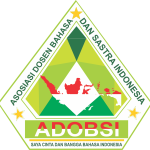CODE-SWITCHING AS MEDIA SPEECH: AN EVIDENCE IN INDONESIAN PODCAST
Abstract
A communicative code plays a main role in every conversation. The aim is to make a communicative goal in every situation. In this digital era, people tend to make something interesting to attract people’s attention. Namely Podcast, is one of the programs in digital platform that been used as the media to share everything in audio output. In Podcast, the host uses code-switching to make the communication livelier and sometimes to emphasize the statements or questions. Therefore, the host and the guest will have a very communicative interaction along the interview. This study aims to analysed the situational goal in a Podcast which host uses English as his switching code. The situational goal can be seen from the type of code-switching that the host used connected to the type of illocutionary forces at the speech act level. The data are recorded and transcribed from several episodes of the Podcast. The result shows that code-switching as the media speech is deliberately use as a very functional code to reach the situational goal.
Keywords
Full Text:
PDFReferences
Al-Qaysi, Noor. Al-Emran , Mostafa. (2015), Code-switching usage in social media: a case study. International Journal of Information Technology and Language Studies (IJITLS). Vol. 1, Issue. 1, (2017). pp. 25-38.
Auer, Peter. (1998). Code-switching in conversation. London and New York: Routledge
Austin, J.L. (1962). How to do things with words. Cambridge: Harvard University Press.
Bahrun, ST. Rahmaniah. Aminah, Sitti. (2020), The use of code-switching in English Foreign Language classroom of SMKN 2 Sinjai (Penggunaan alih kode pada kelas Bahasa Inggris Di SMK Negeri 2 Sinjai), Jle: Journal of Literate English Education Study Program, Vol. 01, No. 01 2020.
Edwards, John. (1994). Multilingualism. London: Routledge.
Fachriyah, Eva. (2017). The functions of code switching in an English language classroom. Studies in English Language and Education, 4(2), 148-156.
Hoffmann, Charlotte. (1991). An introduction to bilingualism. New York: Longman Inc.
Holmes, Janet. (2001). An introduction to sociolinguistics: second edition. England: Pearson Education Limited.
Hornberger, N. H., & McKay, S. L. (2010). Sociolinguistics and language education. Great Britain: Short Run Press.
Idris, S. (2016). The impact of globalization, language policy, and language learning on identity construction: An ethnographic case study of a high school community in Bima, Indonesia. (Unpublishhed Dissertation). The University of Texas at San Antonio.
Kavada, Anastasia. (2015), Social media as conversation: A manifesto. Sage Journals. Doi: https://doi.org/10.1177/2056305115580793
Kristanto, J., Meilasari, P. (2018), Reasons for social media users’ code switch, Advances in Social Science, Education and Humanities Research (ASSEHR), vol.188, Doi: https://doi.org/10.2991/eltlt-18.2019.71
Lee, Sophia Yat Mei, & Wang, Zhongqing. (2015), Emotion in code-switching texts: Corpus construction and analysis. Proceedings of the Eighth SIGHAN Workshop on Chinese Language Processing (SIGHAN-8).
Lubis, I.S., Surya, S., Muka, A.U. (2017). The use of code-switching among the late adolesecents in social media Facebook. CaLLs: Journal of Culture, Arts, Literature, and Linguistics. Vol.3, No.2, DOI: http://dx.doi.org/10.30872/calls.v3i2.817
Maharjan et al., (2015), Developing language-tagged corpora for code-switching tweets. Proc. LAW IX at NAACL. DOI: http://dx.doi.org/10.3115/v1/W15-1608
Mave, Deepthi., Maharjan, Suraj & Solorio, Thamar. (2018), Language identification and analysis of code-switched social media text. Proceedings of The Third Workshop on Computational Approaches to Code-Switching.
Puspawati, I. (2018). Teachers’ use of code switching in EFL classroom and its functions. Journal of Foreign Languange Teaching and Learning, 3(1), 73–74. https://doi.org/10.18196/ftl.3128
Rahayu, D. (2016). Bilingualism of two Indonesian siblings living in Australia. Studies in English Language and Education, 3(2), 109-121.
Retnawati, Saptina. Mujiyanto, Yan. (2015). Code switching used in conversations by an American student of the Darmasiswa program. Language Circle: Journal Lof Language And Literature X/1, 10(1), 29-35.
Rijhwani, Shruti. Sequiera, Royal. (2017), Estimating code-switching on twitter with a novel generalized word-level language detection technique. Proceedings of the 55th Annual Meeting of the Association for Computational Linguistics. Computational Linguistics. https://doi.org/10.18653/v1/P17-1180
Searle, J. (1976). A classification of illocutionary acts. Language in Society, 5(1), 1-23. Doi: 10.1017/S0047404500006837
Soliha, Imro Atus . Susandi , Ari, & Prasetiya, Benny. (2020), English-Indonesian code switching applied in Pondok Pesantren Terpadu Miftahul Ulum Al-Yasini Pasuruan. Premise; Journal of English Edication and Applied Linguistics. Doi: http://dx.doi.org/10.24127/pj.v9i2.3086
Schivinski, Bruno. Dabrowski, Dariusz. (2014), The effect of social media communication on consumer perceptions of brands. Journal of Marketing Communictaions. Doi: https://doi.org/10.1080/13527266.2013.871323
Turmudi, D., & Hajan, B. H. (2020). Education system and English Language Teaching in the Philippines: Implications for Indonesian EFL Learning. Premise: Journal of English Education and Applied Linguistics, 9 (1), 78-93. https://doi.org/10.24127/pj.v9i1.2791
Yuliana, N., Luziana, A. R., Sarwendah, P. (2015). Code-mixing and code-switching of Indonesian celebrities: A comparative study. Lingua Cultura. Vol.9 No.1 May 2015, 47-54, Doi: https://doi.org/10.21512/lc.v9i1.761
Refbacks
- There are currently no refbacks.






